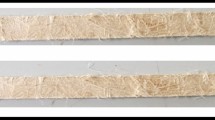Abstract
Long-term weathering tests revealed that glass fiber-reinforced cement (GFRC) might exhibit tensile strength reduction and ductility loss with aging. The main goal of this research was to assess the effectiveness of polyvinyl alcohol (PVA) powder in enhancing the durability characteristics of GFRC sheets. Accelerated aging was achieved by using low pressure steam curing. The strength and ductility of GFRC sheets were measured by the direct tension test. The test results show that the incorporation of PVA powder into GFRC improves the mechanical behavior and changes the failure mode from brittle to ductile. To investigate the mechanism of the enhancement, the fiber-matrix interface was examined by polarizing optical microscopy and scanning electron microscopy (SEM) with energy dispersive X-ray analysis (EDAX). It was found that the addition of the PVA powder results in the deposition of a polymeric film on the fiber surface and thus prevented the accumulation of calcium hydroxide in the interfacial zone. The use of the PVA powder led to a more ductile interfacial microstructure and to better bonding between fiber and matrix, which is believed to be responsible for the tensile property enhancement.
Résumé
Des essais de vieillissement à long terme réalisés sur des échantillons en ciment renforcé de fibres de verre (CRFV) ont montré une diminution de leur résistance à la traction et une perte de ductilité avec le temps. L'objectif principal de cette étude est d'évaluer le rôle de l'ajout d'une poudre de polyvinyle alcool (PVA) sur l'amélioration de la durabilité des matériaux à base de ciment renforcés de fibres de verre. Des essais de traction simple ont permis de mesurer la résistance à la traction et la ductilité d'échantillons de CRFV. Les résultats montrent que l'ajout de poudre PVA dans le CRFV améliore les résistances mécaniques et change le mode de rupture fragile en une rupture ductile. Afin de mettre en évidence les mécanismes d'amélioration des performances mécaniques, des observations de l'interface fibre/matrice ont été effectuées au moyen d'un microscope otique et électronique à balayage (MEB), et une analyse aux diffractions de rayons X (DRX) a été réalisée. Les observations montrent que l'ajout de poudre de PVA permet de créer un dépôt d'un film polymérique à la surface de la fibre et prévient ainsi l'accumulation de l'hydroxyde de calcium à la l'interface fibre/matrice. L'incorporation de la poudre PVA dans un ciment renforcé de fibres de verre permet d'obtenir une interface plus ductile et d'améliorer l'adhérence fibre/matrice qui a pour rôle d'augmenter les propriétés en traction du composite.
Similar content being viewed by others
References
Bentur, A. and Diamond, S., ‘Effect of aging of glass fiber reinforced cement on the response on an advancing crack on intersecting a glass fiber strand’,International Journal of Cement Composites & Lightweight Concrete 8(4) (1986) 213–222.
Hayashi, M., Sato, S. and Fujii, H., ‘Some ways to improve durability of GFRC’, Proceedings, Durability of Glass Fiber Reinforced Concrete Symposium, Prestressed Concrete Institute, Chicago, 1985, 270–284.
Shah, S.P., Ludirdja, D., Daniel, J.I. and Mobasher, B., ‘Toughness-durability of glass fiber reinforced concrete system’,ACI Materials Journal 85(5) (1988) 352–360.
Bentur, A. and Diamond, S., ‘Aging and microstructure of glass fiber cement composites’,Durability of Building Materials 4(3) (1987) 201–226.
Bijen, J., ‘Durability of some glass fiber reinforced cement composites’,ACI Materials Journal 80(4) (1983) 305–311.
Soroushian, P., Tlili, A., Yohena, M. and Tilsen, B., ‘Durability characteristic of polymer-modified glass fiber reinforced concrete’,ACI Materials Journal 90(1) (1990) 40–49.
Chu, T.J., Kim, J.H., Park, C. and Robertson, R.E., ‘Microstructure of cement-based systems/bonding and interfaces in cementitious materials’, Proceedings of MRC, S. Diamondet al. (eds.), 1995, 347–355.
Kim, J.H., Robertson, R.E. and Naaman, A.E., ‘Structure and properties of poly(vinyl alcohol)-modified mortar and concrete’,Cement and Concrete Research 29(3) (1999) 407–415.
Chu, T.J., Robertson, R.E., Najm, H. and Naaman, A.E., ‘Effects of Poly(vinyl alcohol) on Fiber Cement Interfaces. Part II: Microstructures’,Advanced Cement Based Materials 1(3) (1994) 122–130.
Najm, H., Naaman, A.E., Chu, T.J. and Robertson, R.E., ‘Effects of poly(vinyl alcohol) on fiber cement interfaces. Part I: Bond stress-slip response’,Advanced Cement Based Materials 1(3) (1994) 115–121.
Li, Z., Xu, M. and Chui, N., ‘Enhancement of rebar (smooth surface)—concrete bond properties by matrix modification and surface coatings’,Magazine of Concrete Research 50(1) (1998) 49–57.
Zhu, W. and Bartos, P. J. M., ‘Assessment of interfacial microstructure and bond properties in aged GRC using a novel microindentation method’,Cement and Concrete Research 27(11) (1997) 1701–1711.
Litherland, K.L., Oakley, D.R. and Proctor, B.A., ‘The use of accelerated ageing procedures to predict the long term strength of GRC composites’,Cement and Concrete Research 11(3) (1981) 455–466.
Li, Z. and Mu, B., ‘Application of extrusion for manufacture of short fiber reinforced cementitious composite’,Journal of Materials in Civil Engineering 10(1) (1998) 2–4.
Shao, Y. and Shah, S.P., ‘Mechanical properties of PVA fiber reinforced cement composites fabricated by extrusion processing’,ACI Materials Journal 94(6) (1997) 555–564.
Marusin, S.L., ‘Sample preparation—The key to SEM studies of failed concrete’,Cement and Concrete Research 17 (1995) 311–318.
Jin, W., ‘Alkali-silica reaction in concrete with glass aggregate—A chemo-physico-mechanical approach’,PhD Thesis, Columbia University, 1998.
Ohama, Y., ‘Handbook of Polymer-Modified Concrete and Mortars’, (Noyes Publication, Park Ridge, NJ, 1995).
Author information
Authors and Affiliations
Rights and permissions
About this article
Cite this article
Qian, X., Shen, B., Mu, B. et al. Enhancement of aging resistance of glass fiber reinforced cement. Mat. Struct. 36, 323–329 (2003). https://doi.org/10.1007/BF02480872
Received:
Accepted:
Issue Date:
DOI: https://doi.org/10.1007/BF02480872




